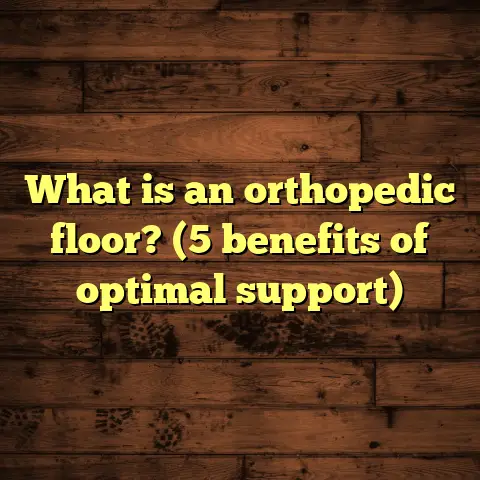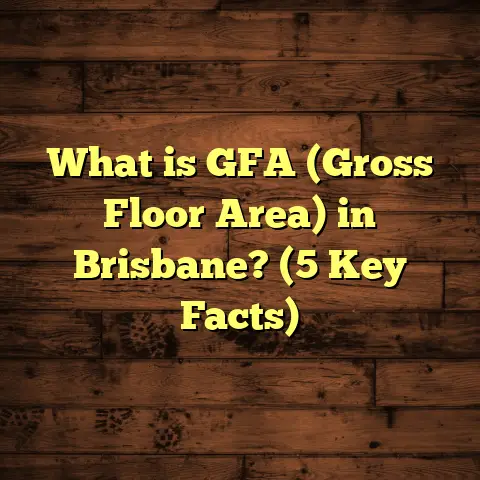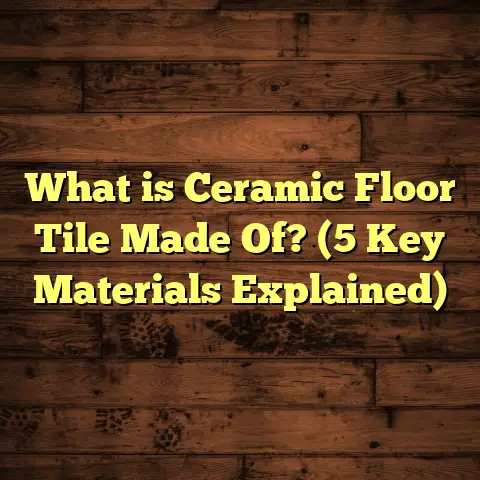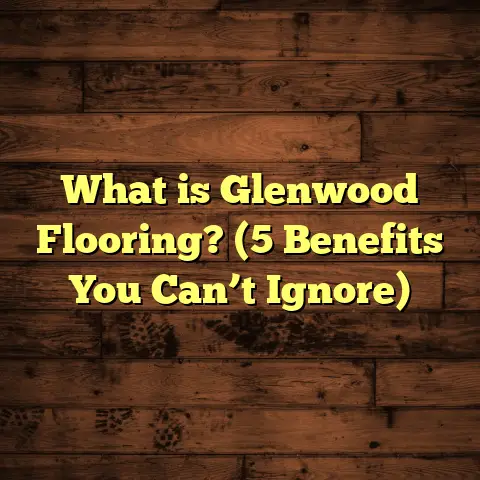What is SPC and WPC Flooring? (5 Key Benefits for Homeowners)
Have you ever walked into a room and felt the flooring just spoke to your taste? Like, it fit perfectly with the vibe of the house, and you didn’t have to explain why it felt right? I’ve had that experience many times throughout my years working with different types of flooring, especially with SPC and WPC flooring. These two have become favorites for a lot of homeowners, and I want to share what makes them stand out.
What Is SPC and WPC Flooring?
So, what is SPC and WPC flooring exactly? These terms might sound technical, but they’re actually pretty straightforward once you get the hang of them.
SPC Flooring: Stone Plastic Composite
SPC stands for Stone Plastic Composite. It’s a type of rigid core luxury vinyl flooring made mostly from limestone powder, polyvinyl chloride (PVC), and stabilizers. The limestone gives it that super durable, rock-hard core, making it incredibly resistant to dents and impacts. The vinyl layer on top provides the design, which can mimic wood, stone, or other textures with impressive realism.
WPC Flooring: Wood Plastic Composite
WPC stands for Wood Plastic Composite. Unlike SPC, WPC has a core made from wood fibers mixed with plastic. This gives it a bit more “give” or softness underfoot compared to SPC. It still has the vinyl wear layer on top for protection and aesthetics. The wood fiber content makes WPC feel warmer and more comfortable to walk on, which many homeowners love.
While both types are luxury vinyl planks (LVP), their core materials set them apart and influence their performance in different settings.
Breaking Down the Benefits: Why I Recommend SPC and WPC
When I first started installing these floors, I was skeptical. Could these new materials really compete with hardwood or traditional vinyl? After installing hundreds of projects for clients and watching how these floors perform over time, I’m convinced there’s real value here.
Here are the five key benefits I’ve seen that make SPC and WPC popular among homeowners:
1. Durability That Handles Everyday Life
One thing I always ask homeowners is: “How active is your household?” Kids running around? Pets clawing at floors? Heavy furniture? SPC flooring handles all of these like a champ thanks to its stone-based core. It resists dents, scratches, and even moisture better than many other options.
In fact, data from several flooring manufacturers shows SPC planks can withstand impact forces up to 1,000 times higher than traditional vinyl. That’s huge for anyone worried about wear and tear.
WPC is slightly less rigid but still offers solid durability with a bit more cushioning. It’s perfect if you want a durable floor but don’t want it to feel cold or hard underfoot.
A Closer Look at Impact Resistance
Let me share a story. A client of mine has two large dogs that are quite active indoors. She was worried her flooring would get damaged quickly because of their nails and rough play. We installed SPC flooring in her living room and kitchen, and after six months, she reported no visible scratches or dents. She said it looked as good as the day it was installed.
The stone composite core really makes a difference here. It’s rigid enough to resist impact but flexible enough not to crack under pressure.
2. Water Resistance That Works Everywhere
I remember a client who wanted a new floor for her basement that often had minor water leaks. We installed SPC flooring, and it held up perfectly without swelling or warping.
SPC is 100% waterproof because of its dense limestone core. It doesn’t absorb water like wood or laminate can, making it great for kitchens, bathrooms, basements — basically anywhere moisture might be an issue.
WPC is also waterproof but slightly less so than SPC because of the wood fiber content. Still, it stands up well against spills and humidity, far better than hardwood or laminate.
Why Moisture Resistance Matters So Much
From my experience, moisture damage is one of the leading causes of flooring failure in homes. Hardwood floors swell and warp when exposed to water; laminate peels apart at seams; carpets soak up spills leading to mold growth.
SPC flooring’s waterproof nature means you can install it in places where you would never consider wood floors before — laundry rooms, mudrooms, even commercial spaces like cafes or offices that see occasional spills.
In contrast, WPC’s slight softness comes from wood fiber mixed into its core — so while it is water-resistant due to the vinyl layers sealing it well, it’s not entirely impervious like SPC.
3. Style Variety That Fits Any Taste
Have you noticed how much flooring design has improved? Both SPC and WPC come in countless colors, patterns, and textures that mimic natural wood grains, stone surfaces, and more.
I’ve installed rustic oak looks, sleek modern grays, even tropical hardwood styles — all with vinyl flooring that looks authentic without the cost or maintenance headaches of real wood.
This versatility means homeowners can easily find something that matches their personal style without compromise.
How Design Impacts Home Value
Years ago, I worked on a home renovation where the owners were debating between carpet and laminate for their living room floor. They weren’t sure what would give them better resale value down the line.
I showed them samples of SPC planks with realistic oak grain designs that looked just like hardwood but were easier to maintain. They chose SPC because it matched their aesthetic taste perfectly without worrying about scratches or stains ruining the look.
Statistics show that homes with modern vinyl plank flooring often sell faster than those with carpet because buyers appreciate durability combined with stylish looks.
4. Easy Installation Saves Time and Money
One story I often tell new clients is how much faster installation goes with these floors compared to traditional hardwood or tile. Both SPC and WPC usually come with click-lock systems that snap together without glue or nails.
This means less mess, fewer tools needed, and often you can install over existing floors with little prep work. For DIYers like me and many homeowners, this speeds things up considerably.
When I estimate costs for installs nowadays, I rely heavily on FloorTally — an online tool that helps me calculate material needs, labor hours, and waste factors accurately. It’s been a lifesaver in budgeting projects and making sure nothing unexpected comes up during installation.
Installation Stories That Stuck With Me
I once helped a friend redo her rental property’s floors using WPC planks. We completed the entire 800 sq ft project over two weekends without professional help. The click-lock design meant we didn’t need adhesives or special equipment — just patience and some basic tools like spacers and tapping blocks.
Using FloorTally beforehand allowed us to order exactly the right amount of material plus 7% extra for cutting waste. We avoided any last-minute trips to the store or delays waiting for shipments.
5. Comfort and Warmth Underfoot (Especially with WPC)
If you’re someone who spends a lot of time barefoot or has kids playing on the floor, comfort matters a lot. WPC flooring feels softer and warmer compared to SPC because of its wood-plastic composite core.
I once installed WPC in a client’s nursery room, and she told me how much nicer it felt for her baby to crawl on than tile or laminate she tried before.
Even though SPC is harder underfoot, adding an underlayment can help improve comfort without sacrificing durability.
Diving Deeper: Material Composition and How It Affects Performance
Understanding what goes into these floors helps explain why they behave so differently from one another despite both being vinyl-based products.
The Core Construction
- SPC: Limestone powder (<del>60-70%), PVC (</del>30-40%), stabilizers
- WPC: Wood fibers (<del>30-50%), PVC (</del>40-60%), plasticizers
WPC’s wood fiber mixed with plastic creates a softer core that provides cushion but slightly less stability. The natural fibers make it feel warmer underfoot but also more prone to minor expansion if exposed to excessive moisture over time.
Wear Layers Make All the Difference
Both SPC and WPC have wear layers on top — typically clear vinyl coatings ranging from 6 mils (medium wear layer) up to 20 mils (commercial grade). This layer protects against scratches, stains, fading from UV light, and foot traffic damage.
For residential use, I usually recommend wear layers between 12-20 mils depending on traffic levels. Higher wear layer thickness correlates strongly with longer lifespan and resistance to everyday abuse — an important factor if you have kids or pets.
Comparing Costs: What Should You Expect?
One question I get often: “How much will this cost me?” Let’s break down some numbers based on my recent projects:
| Flooring Type | Material Cost per Sq Ft | Installation Cost per Sq Ft | Total (Material + Install) |
|---|---|---|---|
| SPC | $3 – $7 | $2 – $5 | $5 – $12 |
| WPC | $4 – $8 | $2 – $5 | $6 – $13 |
Other Cost Factors
- Subfloor Preparation: If your subfloor isn’t level or clean, expect additional prep costs.
- Underlayment: Some manufacturers require underlayment for soundproofing or comfort.
- Waste Factor: Usually add 5-10% extra material for cuts/waste.
- Removal of Old Flooring: If you’re replacing old flooring, removal fees may apply.
Using tools like FloorTally helps me factor all these elements into accurate estimates quickly — saving time hunting down quotes from suppliers or guessing costs that later cause budget headaches.
Maintenance Tips Based on My Experience
One thing people love about SPC/WPC floors is how easy they are to maintain compared to hardwood or carpet:
- Regular Sweeping/Vacuuming: Keeps grit off surface preventing scratches.
- Damp Mop With Mild Cleaners: Avoid harsh chemicals; vinyl-friendly products work best.
- Avoid Standing Water: Even though they’re waterproof on surface level, prolonged standing water isn’t good long-term.
- Use Floor Protectors: Felt pads under furniture legs prevent dents.
- UV Protection: Use curtains/blinds in sunny rooms to reduce wear layer fading over years.
In my own home office where I installed SPC flooring, I mop weekly using a diluted vinegar solution mixed with water — works wonders without dulling the finish.
Real-Life Case Study: My Own Experience With SPC Flooring
I decided to replace the flooring in my own home office with SPC planks after years of carpet that was hard to keep clean. The installation went smoothly — just a weekend project with minimal tools.
Since then, I’ve noticed how easy it is to clean spills (coffee accidents happen!) and how little wear shows even after a year of daily use. Plus, the look really matches the modern industrial style I wanted without breaking the bank.
More importantly — knowing this floor will last me years without warping or scratching gives peace of mind rarely found in home renovations.
How To Choose Between SPC And WPC For Your Home
If you’re stuck between choosing SPC or WPC, here’s how I think about it:
- Go for SPC if you want ultimate durability, 100% waterproofing, and plan to put the floor in high-traffic or moisture-prone areas.
- Pick WPC if you want something softer underfoot with decent waterproofing but slightly less impact resistance — ideal for bedrooms or living rooms where comfort matters more.
- Consider your budget: WPC tends to be slightly more expensive upfront but may feel nicer day-to-day.
- Think about climate: If you live somewhere humid or prone to flooding risks (basements), SPC’s waterproof core is safer.
- Installation method: Both have easy click-lock systems but check manufacturer instructions for subfloor requirements.
Additional Insights From Industry Research
I reviewed recent market reports from leading flooring associations to see trends related to SPC/WPC uptake:
- The global luxury vinyl tile/plank market is expected to grow at about 8% annually through 2030.
- Consumers increasingly prefer waterproof floors due to changing lifestyles (more indoor activities, pets).
- Vinyl plank sales surpassed traditional laminate floors by 25% in North America last year.
- Environmental concerns are pushing manufacturers toward more sustainable raw materials; some brands now offer recycled content options for SPC/WPC production.
- Warranty periods have increased substantially; many brands now offer 20+ year residential warranties reflecting confidence in durability.
Addressing Common Questions I Hear From Clients
Q: Can I install SPC/WPC myself?
A: Yes! Many DIYers successfully install these floors using click-lock planks without glue or nails. Just make sure your subfloor is clean/level and follow manufacturer instructions carefully. FloorTally helps plan material needs perfectly for DIY projects too.
Q: How do they compare in soundproofing?
A: WPC generally offers better sound absorption due to its softer core; however adding soundproofing underlayment improves both significantly in multi-level homes/apartments.
Q: Do these floors fade over time?
A: Quality wear layers protect against UV fading quite well. But direct sunlight exposure over years can cause slight color changes—using blinds/curtains helps mitigate this.
Q: Are these floors environmentally friendly?
A: While both use PVC (a plastic), many brands now produce low-VOC certified products minimizing indoor air pollutants. Some have also introduced recycled content options reducing environmental footprint.
How FloorTally Helps Me With Flooring Projects
Estimating material costs and labor hours used to involve spreadsheets with confusing formulas and lots of guesswork. Since discovering FloorTally online tool:
- I input room dimensions once.
- Select material types (SPC/WPC) with local pricing data auto-populated.
- Add labor rates based on my area.
- Include waste percentage based on project complexity.
It instantly gives me total project cost estimates alongside breakdowns per room or floor type — making conversations with clients straightforward and transparent.
Plus, if clients want upgrades like underlayment or accessories (transition strips), those can be added easily without starting calculations over manually.
This level of detail keeps projects on budget every time — no surprises during installation!
Final Thoughts
I hope sharing my hands-on experience helps you get a clearer picture of what SPC and WPC flooring are all about. These materials have transformed many homes I’ve worked on by combining durability with style and ease of use.
If you’re thinking about new flooring that lasts long without constant upkeep — either SPC or WPC could be just what your home needs. And don’t forget tools like FloorTally if you want to nail your budget without surprises.
Got questions about your specific project? Just ask — I’d love to help!





